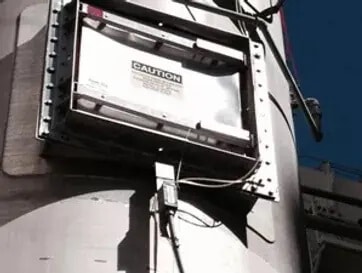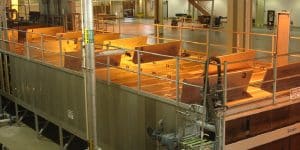In the food industry as well as other forms of manufacturing, there is often a risk of too much pressure building up inside of machines, such as boilers, ring dryers, brewery tanks, and so forth. The resulting explosions can cause severe injuries and even fatalities, not to mention create significant damage to your facility.
As such, it’s important to take measures to both prevent these explosions and also mitigate damage should they occur.
When it comes to preventing damage from excessive pressure buildup, there are two main options available: rupture discs and explosion doors.
What is a Rupture Disc?
Rupture discs, also known as explosion vents, are non-reusable devices installed on pressurized equipment. If the pressure builds up, it causes the disc to break open, releasing pressure and preventing a catastrophic explosion.
Typically, they’re round in shape, but they frequently come in rectangular configurations as well, in which cases they’re referred to as rupture panels or explosion panels.
Components of a rupture disc
The central component of a rupture disk is the metal membrane used. That membrane is held under tension over a vent in the system, and it is designed to break once the pressure building up behind it exceeds established parameters.
Some rupture disc membranes have scores cut into them, allowing the breakage to be more controlled.
There are two types of rupture discs: forward-acting and reverse buckling.
- Forward-acting rupture discs bulge outward, and pressure is applied to the concave side.
- Reverse buckling rupture discs bulge inward, allowing pressure to build on the convex side.
Since these devices are designed to break, they need to be replaced if they ever burst.
Advantages of rupture discs
While rupture discs aren’t reusable, they still have many advantages over other options like explosion doors. These include:
- Lightweight, which means they tend to be more sensitive
- Fewer moving parts, so they require less maintenance
- Some are designed to close up on their own, preventing combustible fumes from escaping
- Easy to install and replace when needed
Downsides of rupture discs
Although rupture discs have their uses, they also have some downsides to keep in mind:
- Prone to metal fatigue, particularly on forward-acting models
- Require replacement before machines can be put back online, increasing repair times
- May fail to burst if installed improperly
- May release combustible fumes into a facility upon bursting, leading to a chimney effect
- The metal membrane is susceptible to damage or corrosion, leading to pinhole leaks or premature breakage
What are Explosion Doors?
Food manufacturers and brewers looking for more permanent safety fixtures in their facilities might opt for explosion doors over rupture discs. Explosion doors are simply that: a door fixed to the unit that’s designed to burst open when the pressure exceeds safe parameters. Afterward, they close up again on their own.
Components of explosion doors
The core mechanism of explosion doors is a hinged flap. However, they may also include components that are designed to keep the unit from damaging itself while flying open and to make sure it works correctly.
The exact design depends on the manufacturer, with some models having integrated plates that stop the flap from opening too wide or vacuum breakers to keep the vent from causing a vacuum upon closing.
Advantages of explosion doors
Explosion doors have several advantages over rupture discs, including:
- Reusability, since they reclose after an explosion event
- Less metal fatigue than forward-acting rupture discs
- Less equipment downtime since they’re designed to close automatically and don’t need replacement
- Automatic closure, reducing fumes from an explosion event
Downsides of explosion doors
Just like rupture discs, explosion doors have a few downsides as well, including:
- Higher weight, meaning they may fail to open in the event of an explosion
- Moving parts prone to wear or corrosion
- Higher maintenance to keep in working condition
- Limited applications
Should You Switch To Explosion Doors On Your Machines?
The choice of whether to use an explosion door or rupture disc on your high-pressure machines depends on your specific applications, the type of process you have going, and the capabilities of your maintenance team.
Inertia
If the potential explosions in your facility would have a lot of inertia—more or less meaning they’d have more weight behind them—then explosion doors would be a sound option. As long as you keep them well maintained, they should serve you well.
On the other hand, if the pressures involved in your process equipment wouldn’t be enough to open an explosion door if they get to be too much, you’d likely find rupture discs to be a safer option.
Process type
Continuous processes have less room for downtime, which means an explosion door would likely be a better option wherever possible. On the other hand, a batch process would probably handle rupture discs better, though explosion doors would typically still be preferred.
Note that equipment downtime can get enormously expensive, in some cases reaching as high as $30,000 per hour. As such, if you can save on unplanned downtime with an explosion door, it’s often going to be a better option.
Installation costs
In general, rupture discs are much easier to install on equipment than explosion doors. They have to be—they are designed to break upon activation, after all. Retrofitting a machine with explosion doors can be expensive, so it depends on whether the installation cost would outweigh the time and resources spent replacing burst discs.
Choosing The Right Option For Your Process
Ultimately, the decision of whether to use rupture discs or an integrated explosion door comes down to your process and capabilities. Consulting with a contract manufacturer can help you determine which option is best for your facility.






 Contract
Contract Food & Bev
Food & Bev